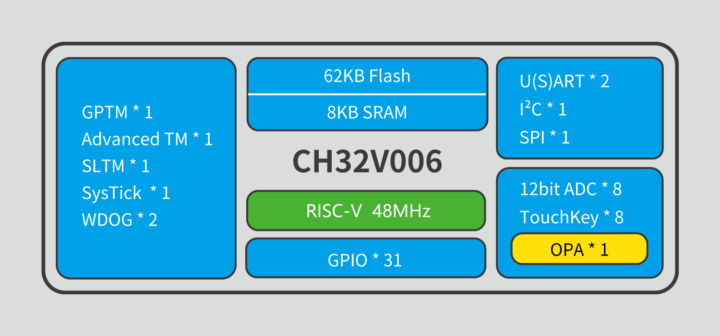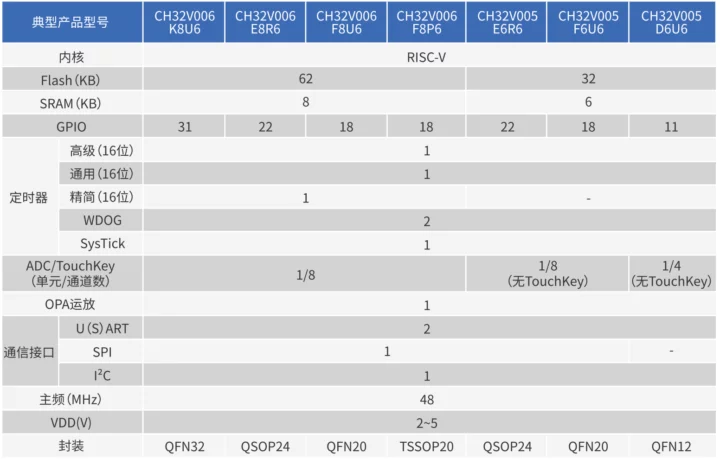WCH CH32V006 RISC-V microcontroller is an upgrade to the 10-cent CH32V003 microcontroller with more I/Os, up to four times the memory, storage, a wider supply voltage range, the addition of a TouchKey interface, as well as a new 32-bit V2C RISC-V core instead of the V2A core found in the CH32V003.
More specifically that means we went from the CH32V003 with 2KB SRAM and 8KB flash, up to 8KB SRAM and 62KB for the CH32V006, and 6KB SRAM and 32KB flash for the CH32V005, a smaller sibling of the new RISC-V microcontroller.

WCH CH32V005 & CH32V006 specifications (with highlights in bold to show differences against CH32V003):
- CPU – 32-bit “RISC-V2C” core up to 48 MHz
- Memory – 6KB SRAM (CH32V005) or 8KB SRAM (CH32V006)
- Storage – 32KB flash (CH32V005) or 62KB flash (CH32V006)
- Peripherals
- Up to 31x GPIO with interrupt support (CH32V003 had up to 18x GPIO)
- 2x USART interfaces
- 1x I2C
- 1x SPI
- 12-bit ADC up to 8 channels; TouchKey interface (CH32V006 only)
- 1-wire or 2-wire debug interface
- Operational amplifier (OPA)
- General purpose DMA controller
- Timers
-
- 16-bit advanced timer
- 16-bit general-purpose timer
- 16-bit “simplified” () timer (CH32V006 only)
- 2x watchdog timers
- 32-bit system timer
-
- Misc – 96-bit chip unique ID
- Supply voltage – 2V to 5V (CH32V003 was 3.3V or 5V)
- Low power modes – Sleep, standby
- Power on Reset (POR), programmable voltage detector
- Packages
- CH32V005 – QFN12, QFN20, QSOP24
- CH32V006 – TSSOP20, QFN20, QSOP24, QFN32
We can see some packages are the same as the CH32V003, but they may not be pin-compatible considering the extra interfaces. There’s no product page just yet and the datasheet is not available. The new CH32V005/6 microcontroller showed up in the product guide (PDF) and Patrick Yang, CTO at WCH, tweeted (X’ed?) about the upcoming CH32V006 MCU providing a few extra details and offering free samples to those interested. More information and documentation should surface once the new MCUs get closer to mass production.
Thanks to David for the tip.

Jean-Luc started CNX Software in 2010 as a part-time endeavor, before quitting his job as a software engineering manager, and starting to write daily news, and reviews full time later in 2011.
Support CNX Software! Donate via cryptocurrencies, become a Patron on Patreon, or purchase goods on Amazon or Aliexpress





